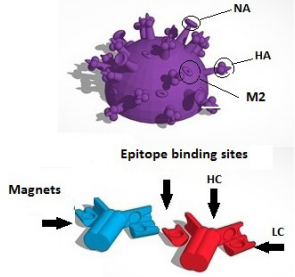
One of the more difficult concepts for college students to understand, the researchers explain, is the interaction between antibodies and the multiple epitopes found on antigens. Two students, as part of an honors thesis, designed 3D models of antibodies and viruses using Tinkercad. The program allowed them to create an intricate design, placing antibody cylinder “solids” onto viral antigen “holes” to demonstrate their binding. They also designed a cartoon version of an Influenza A virus as their model.
With help from the university’s Idea2Product Lab, the researchers 3D printed their models using PLA and Afinia 3D printers.
- Describe how antigens and epitopes are related
- Explain why some antibodies that do not bind to epitopes are produced
- Discuss which regions on the heavy and light chains come together to bind to specific isotopes
- Identify the region on the antibody that determines its class or isotope
“In total, they will work with four different combinations, two of which will bind an epitope on the same antigen on the virus, and two of which will not have specificity for the virus,” the researchers explain. “This allows students to understand that not all antibodies will be specific for an epitope on an infecting microbe.”
Over four semesters of using the 3D printed kits, 91% of students were able to correctly identify the epitope to which an antibody would bind.
Interestingly, when the combination of heavy and light chains did not bind to any epitopes on the virus only 63% of students answered that the antibodies were not specific for any epitope,” the researchers continue. “This could indicate either that students do not understand that not all of the randomly created antibodies will have specificity for a given infection, or they are not confident enough to answer ‘none of these’. However, after seeing the first antibody that was not specific for any epitopes and discussing how this was possible, when they were given a second antibody that was not specific for the virus 91% answered ‘none of these’, and 96% correctly identified the epitope binding site of the second antibody that had viral specificity.”
No matter the age of the student, 3D printed models can be valuable tools to help with understanding concepts – whether it’s preschool students learning shapes and colors or college students learning about antibodies and epitopes. Some things can be understood much better with interactive physical representations, and 3D printing allows educators to easily and inexpensively tailor models for certain lessons. In addition to learning how a single antigen could have multiple epitopes, students were able to use the 3D printed kits to explore concepts such as agglutination, crosslinking, neutralization, and isotypes. The 3D models are available on Thingiverse.
Authors of the paper include Erica L. Suchman, Jennifer McLean, Steven T. Denham, Dana Shatila, and David Prowel.
Discuss this and other 3D printing topics at 3DPrintBoard.com or share your thoughts below.